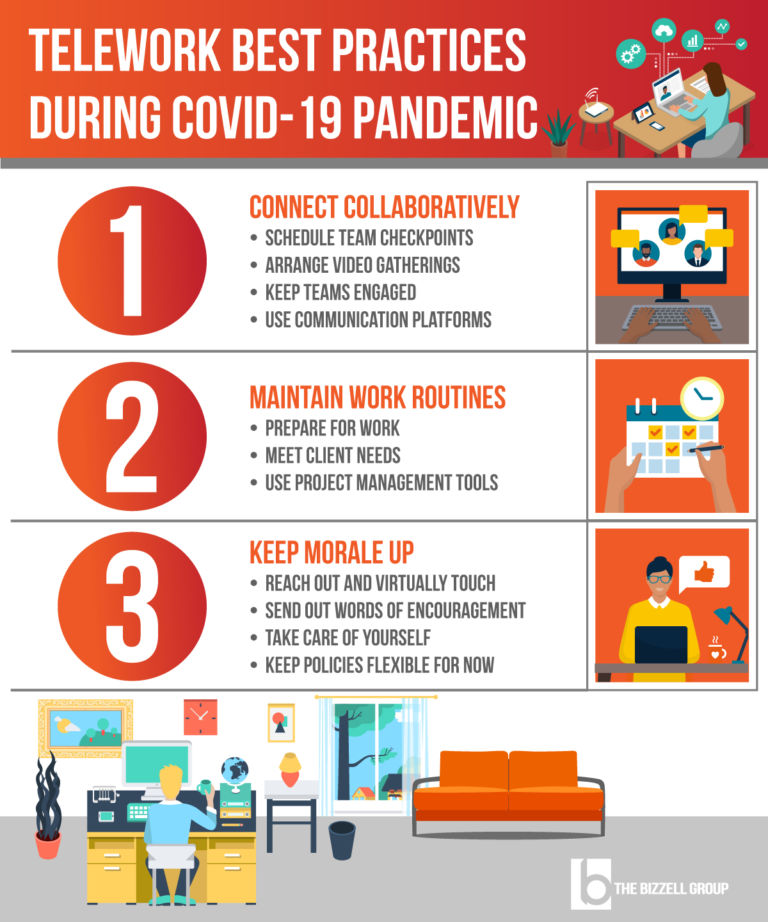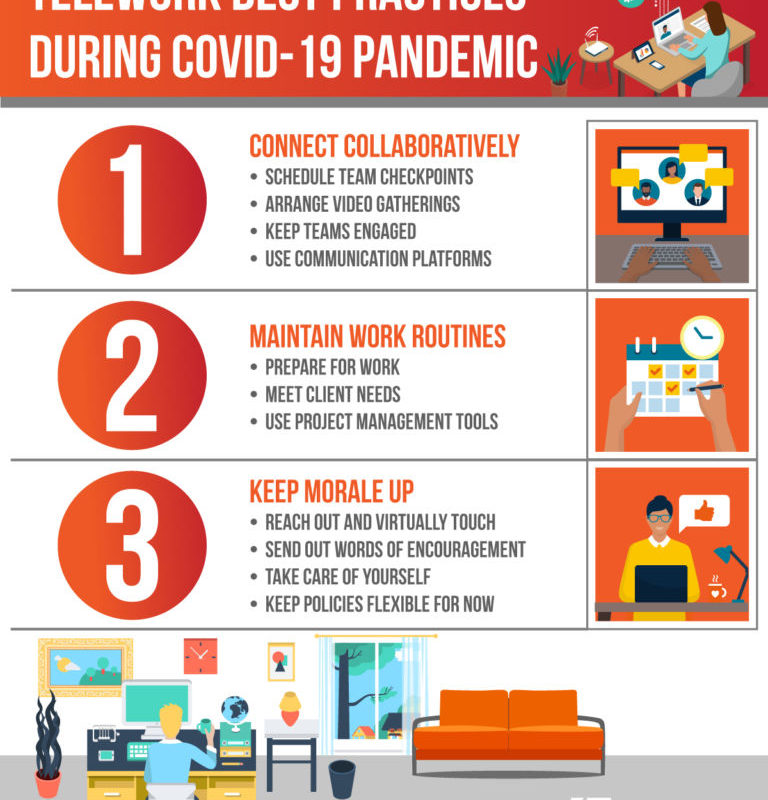Telework Best Practices: Tips for Staying Connected during COVID-19 Pandemic

Written by: Almeda Kyser
The novel coronavirus (COVID-19) has transformed how and where we work. Businesses are rushing to transform the workplace as virtual workspaces become the norm. For the Bizzell Group (Bizzell), meeting remotely from across the globe is nothing new, but recent events have required more creative approaches. Bizzell Vice President for Conference Services, Almeda Kyser shares telework best practices when your only commute is along the internet superhighway.
Find ways to connect collaboratively: Now that we don’t have human, face-to-face interaction we are forced to be more strategic and innovative, Almeda says, and that means we must connect more often –don’t let a week go by without some form of group engagement.
- Schedule team checkpoints: Add brief, 15-minute, every-other-day remote team meetings into the weekly schedule, preferably in the mornings, to give teams a chance to share project status and updates.
- Arrange video gatherings: Once-a-week bring teams together with live streaming events for no more than 30 minutes – in addition to recurring department meetings — to give teams the chance to see each other and just check in. These can be informal gatherings that start with work discussions and segue into some fun social time.
- Keep teams engaged: To break the daily monotony, Almeda sends out trivia polls and questions to keep brains active and teams talking. She also recommends periodic virtual round table discussions, just 15-to-30 minutes in length, on various subjects to keep the excitement going. Almeda plans to implement daily educational webinars for professional development so that teams expand their professional horizons.
- Use communication platforms: Just like water cooler gatherings of old, it’s important to create an informal gathering space. Almeda employs virtual methods like productivity platforms and real-time instant messaging applications to keep individuals and teams in touch and informed while saving email space for more formal missives.
Maintain work routines: The advantages of working from home include no more running for the school bus or standing in the subway line. We still need to maintain our normal work schedules, Almeda notes, and behave at home the same way we would at the office.
- Prepare for work: Rise and dress according to your regular routine. It’s also important to heed company guidelines about venues that might hinder productivity by monitoring social interaction while working and limiting social media use (some smart phones are equipped with alarms that help users keep social media time to a minimum). Discipline and consistency in work styles is even more important, now, as we face the prospect of working from home not for just a few days but potentially weeks to months.
- Meet client needs: Clients look to us to set the tone for meetings, Almeda points out. When video conferencing with clients, maintain professional etiquette and clothing. Before audio conferences, ensure that file sharing applications are in use, but shut down any other computer applications that might distract you. Bizzell is experienced in using several virtual event platforms to customize virtual events for clients, such as WebEx, Adobe Connects, Zoom, and RingCentral. And, we have established SOPs, checklists, and timelines to ensure that Bizzell facilitates a successful event.
- Use project management tools: Project management tools are integral to our client work at Bizzell, and Almeda encourages using these platforms to manage tasks and deliverables for your internal teams and external clients.
Keeping up morale: Bizzell CEO and senior leadership play a major role, Almeda says, to ensure that the office culture Bizzell has established translates into a virtual culture.
- Reach out and virtually touch: Almeda anticipates more frequent outreach to address concerns that employees may have now and more efforts to engage with each other. For example, create a theme day on Fridays, when groups can collectively wear a theme color, share lunchtime remotely, or enjoy a virtual happy hour. Be sure to celebrate birthdays and work anniversaries. “We love the human compassion from being around each other – it’s important that we don’t become transitional people.”
- Send out words of encouragement: Give your team praise and encouragement – let them know you still value what they do, Almeda urges. She did this with her own team during the first week of teleworking by sending out personal messages to reassure them and let her team know they are appreciated.
- Take care of yourself: It is just as important to care for yourself, and Almeda recommends including exercise in your daily routine. Also focus on your mental health. Take a few minutes to step away from your computer to play a quick game, meditate, for quiet time, spiritual affirmation, or a brief read. Teleworking has allowed for less physical stress and more family time as meals are once again shared at the dining table, she notes, so enjoy the company.
- Keep policies flexible for now: “This is a learning space for everyone,” Almeda notes, “there will be a lot of trial and error about what works and won’t work for Bizzell.” She foresees that companies will become flexible about telework policies as they reassess the need for office space and utilize available technologies that enable live streaming across locations. “Companies have multiple options for teleworking now more than we did 10 years ago, but it’s important to have a plan B in place.”
Bizzell is committed to continuing exceptional work with our clients during the novel coronavirus pandemic and beyond. We keep these principles values in mind while cultivating our teams during telework, and continuously delivering high-quality, client-centered service: Excellence, Integrity, Service, Innovation, People First, Diversity, Collaboration, and Professional Development.
The Bizzell Group (Bizzell) is a strategy, consulting, and technology firm that designs innovative solutions to help build healthy, secure, and sustainable communities in our nation and around the world. We leverage the combined experience of our diverse subject matter experts to develop data-driven, research-informed, innovative solutions to the world’s most complex challenges—ensuring our clients achieve their vision and goals. At Bizzell, we pursue meaningful projects that align with our motto: “Our clients drive real-world change. We accelerate it.” Learn more about how we develop data-driven, research-informed, innovative solutions to SUDs and other complex-real-world challenges: https://BizzellUS.com/




